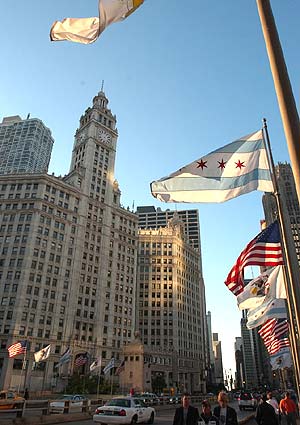Politics of Preservation: Part 2,234,986
 Wrigley Building, Chicago. Chicago Tribune Photo.
Wrigley Building, Chicago. Chicago Tribune Photo.Blair Kamin writes about the case of the Wrigley Building in Chicago, and how Mayor Daley says the city won't designate the building, in "Wrigley Building clearly a landmark: Private-only funding not relevant to designation."
We live in Daleyland. Or Wonderland. Sometimes, it seems as if it's the same place. Mayor Richard M. Daley's recent assertion that the city will not seek landmark status for the iconic Wrigley Building takes us straight through the looking glass and into the realm of the ridiculous. It reveals how utterly arbitrary the process of conferring protected status on Chicago's architectural treasures can be.
The mayor made his comment on June 18 after the Tribune's Thomas A. Corfman revealed that the Wm. Wrigley Jr. Co. is exploring its long-term real estate needs, including a move from its historic headquarters building at 400 and 410 N. Michigan Ave. If the company does move, real estate sources said, the Wrigley Building might be turned into luxury condominiums.Asserting that the city continues to have no interest in pursuing landmark designation for the Wrigley Building, Daley said of the Wrigley family: "That family has really kept that icon up. . . . There isn't one piece of public taxpayer money involved. That's pretty significant."
This was a classic Alice-in-Wonderland argument -- an insidious way of turning reality on its head. Nowhere in the official criteria for designating Chicago landmarks does it say that a building's owners can avoid the restrictions that come with landmark status by maintaining their properties without public funds.
A potential landmark must meet at least two of seven criteria established by the city. Among them: being an important work of architecture (which the Wrigley surely is -- the building, a skillful transformation of Spanish and French precedents, is a major 1920s skyscraper and even appeared on the cover of the Art Institute's 1987 book, "Chicago Architecture 1872-1922").
Here is a sampling of the other standards:
- Whether a building is a critical part of the city's heritage (check: The Wrigley inaugurated a spurt of development north of the Chicago River in the 1920s).
- Whether a building was designed by an important architect (check: The Wrigley's architects were Graham, Anderson, Probst & White, the firm that succeeded the practice of Daniel Burnham).
- Whether a building is part of a distinctive city district (check: The Wrigley is one of four great 1920s towers that create an extraordinary visual drama around the Michigan Avenue bridge).
- Whether a building has a unique visual feature (check: If the Wrigley's clock tower isn't unique, then what is?).
It is absurd for the city's roster of protected structures to incorporate such everyday structures as warehouses, powerhouses, bridges and ballparks but not a major commercial monument such as the Wrigley Building. How can Wrigley Field be a landmark, but not the Wrigley Building?
In recent years, the city has pursued the enlightened policy of taking pre-emptive action, as condominium conversions loomed, to protect significant historic structures, such as the wall of historic buildings along Michigan Avenue that lines Grant Park.
Nobody wanted to see balconies, with bicycles and barbecue grilles, gracelessly stuck onto the walls of these notable structures. Nobody should wish such a fate on the Wrigley Building. And that is to say nothing of the potential issue raised by the blazing spotlights that make the building a beacon at night: There could be pressure to turn them off if they keep condo residents awake.
___________________
This is a problem all across the nation and used to be a much greater problem in DC. The fact that the Historic Preservation Review Board is a somewhat independent body helps insulate this process from politics. In Philadelphia, the Historical Commission has half of its appointees from City Government--certainly no possibility of "suasion" there. Still, the Mayor likely expresses his wishes, and will not reappoint members who buck them on important issues. (Mayor Barry did that with regard to votes on the MCI Center.)
So recent calls in editorials in the Current Newspapers to require that City Council make final approval of historic districts is really worrisome. When you have Councilmembers like Kathy Patterson pandering to her constituents over the debacle of the Tenleytown Fire Station (this fiasco had everything to do with construction management on the part of the Fire Department and nothing to do with preservation), it chills me to the bone to think of Councilmembers applying politics rather than the merit criteria to such decisions.



0 Comments:
Post a Comment
<< Home